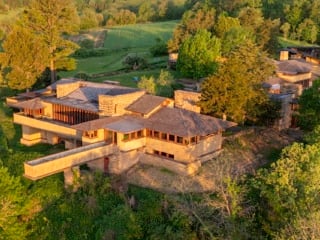
Willey House Stories Part 22: Calling the Kettle Back—Chapter 5: Benefits of the Fireplace
Steve Sikora | Feb 3, 2023
In this seven-chapter subseries of the Willey House Stories, Steve Sikora reflects on Frank Lloyd Wright’s fireplaces, their purpose and meaning—and the search for one missing kettle. Subsequent chapters will follow over the next few weeks.
In my decades-long search for the Willey House kettle, I was pleasantly detoured into an exploration of Frank Lloyd Wright’s fireplaces. All fireplaces, including Wright’s, offer warmth and the promise of sustenance. But with the minimization of those traditional functions, in the modern era, a fireplace exists for a third commonly recognized purpose, the delirious spectacle of a burning fire.
The fireplace: a source of aesthetic pleasure
From the cozy arching rainbow of brick in his 1889 Home and Studio inglenook, to the sunken Robie House hearth of 1910, to the 1901 Henderson House with its elastic, protruding brow of masonry, to the stunning pyramidal fireplace in his Alex Wainer House project of 1952, to the glorious, wrap-around, glass tile mosaic of the 1903 Darwin Martin House, glittering with warmth enough to melt the coldest heart in Buffalo, Wright’s fireplaces are true aesthetic marvels. Different as they may appear, they all share one thing in common—the element of fire.
Homo sapiens relish fire. We always have. Like moths, we are drawn to it. Happily, unlike the ill-fated moth sizzling on the lens of a Colman lantern, this urge is not so fatal an attraction for us. Instead, our gravitation to fire has bolstered human survival in countless ways—offering safety from predation, cold, and hunger. Little wonder then the fire has become a fundamental social center, where families and community alike instinctively gather, simply to be together silently, to make music, feast, imbibe, to pass a pipe, or share stories. Our forebears understood the value of the fire for nearly 2 million years and have plumbed the depths of its mysteries.
That might help explain why, when the world feels as though it is coming apart at the seams one finds solace gazing into the ancient heart of a flickering bonfire. It offers a mental safe harbor. Sitting before a blaze, we exist in a state of repose because we are conditioned to feel at ease. It is a deeply imprinted impulse after a couple of million years. The fire, we know, is a place of safety where we can relax our defenses and look on in a pacified, semi-hypnotic state. Before the fire fleet time passes unnoticed, like sand through an hourglass, our cares tranquilized by the dancing flames. The trance-inducing effect of fire is meditative and restorative. No wonder contemporary domiciles ranging from maligned McMansions to glimmering modernist boxes still provide some semblance of a fireplace, even if they are ersatz gas flame units or electric simulations of the real thing. Because the fireplace, that dependable provider of warmth and sustenance, is also a timeless defender of our mental well-being.
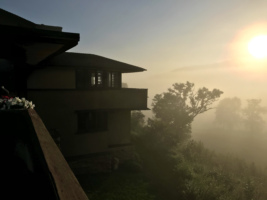
Sunrise at Taliesin is rich with the aromas of the fields and pond. Credit: Steve Sikora
Scientific evidence suggests that tangible benefits arose from our attraction to fire. According to Thomas Wynn in Smithsonian Magazine, “Being mesmerized by fire may have sparked the evolution of the human mind.” Recent research in the field of cognitive evolution, a nexus of psychology, anthropology, neuroscience and genetics—suggests that, “fire’s most lasting impact was how our responses to it altered our brains, helping endow us with capabilities such as long-term memory and problem-solving.”
Fire, the first artificial light source, was harnessed some 1.9 million years ago. The technology gave humans the upper hand in species survival. It was a weapon and a means of warding off predators after dark. Furthermore, archeologist, John Gowlett of the University of Liverpool observed that a byproduct of this technological innovation was that artificial daylight lengthened our waking hours. It transformed how hominid brains regulated time and gave us the advantage of 16-hour days versus the 12-hour days of other fauna. The same article cites psychologist Frederick L. Coolidge of the University of Colorado who argues that fire inherently altered the quality of sleep, in a very positive way. The security provided to early humans by a fire allowed them more time for REM sleep compared to apes and monkeys. It is during rapid eye movement sleep that we experience our most vivid dreaming. Also, in this phase of sleep the brain “consolidates ‘procedural memories’ which allows us to retain skills and repeat previously learned tasks.” Not only was the mastery of fire a significant development, the security it provided helped usher in a cascade of cognitive leaps for early hominids.
Consequently, a haze of aromatic wood smoke is perfume to the primal brain, those parts responsible for survival, drive, and instinct. A mere whiff of smoke sends a message directly to the brain, as we relive family camping trips, scouting weekends, a National Parks lodge fireplace, bonfires on the beach, or burning autumn leaves. Neuroscience recognizes that smell and memory are closely linked because of the brain’s anatomy. Odors take a direct route through the limbic system to the regions of the brain related to emotion and memory. And some of our most persistent memories are olfactory reminders. I vividly recall for instance, the smell of ladybugs, Play Dough, rainwater on pavement, garter snakes, vinyl seat covers, each of my relatives homes, the pumice hand soap my father used, his deer rifle cleaning rag, the soil in my backyard and the puppy I had at two years of age. Events I might not have retained if not for the recollection of smell.
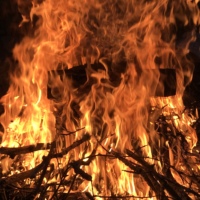
The smell of wood smoke unleashes a cascade of distant memories. Credit: Steve Sikora
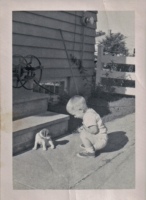
Olfactory memories are among the most persistent. The author as a toddler with his puppy, Shorty Bow Wow. Credit: Steve Sikora
An article in the Harvard Business Review entitled Inside the Invisible but Influential World of Scent Branding describes how particular smells trigger specific feelings “…Scents are selected to represent emotional triggers.” Olfactory brander, Dawn Goldworm says her goal, is to create “immediate and memorable connections between brands and consumers.” A signature scent she developed for Nike, “was inspired by, among other things, the smell of a rubber basketball sneaker as it scrapes across the court and a soccer cleat in grass and dirt.” The fragrance is intended to encourage the subtle recollection of these activities.
What then would compose a Frank Lloyd Wright’s signature scent? And what would it inspire?
Well, unlike the mercilessly “Febrezed,” modern domicile, Wright houses tend to be awash in natural essences—redolent with fragrances of the woods, concrete, plaster, and masonry that compose the structure, layered with notes of the soils and foliage of its immediate native surroundings. Depending on the local climate and season, a Wright house might smell slightly dusty or musty depending. A constituent part of that distinctive bouquet is bound to be the aroma of wood smoke. The familiar hint of smoke and ash that inevitably perfumes Wright homes, contributes to a sense of what the Danish call hygge, a warm and comforting atmosphere. Even for the casual visitor hygge pervades Wright’s houses.
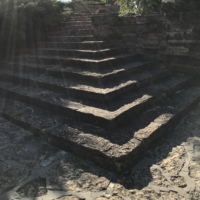
Limestone and perennials contribute to the perfume of Taliesin. Credit: Steve Sikora

The smells of something old are layered with the fragrances of fresh green growth. Credit: Steve Sikora
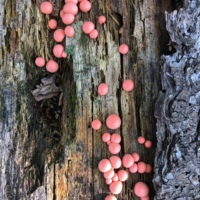
Every whiff of the outdoors reminds us of the eternal cycles of renewal and patterns of Nature. Credit: Steve Sikora
In Section Five of the 1943 edition of Wright’s An Autobiography, he included a section entitled Sniff Taliesin. In the 1977 edition, the title was changed to The Taliesin Sniff.
Wright begins by describing the environmental fragrances of spring and summer when the windows at Taliesin are thrown wide-open.
“The odor of the long white drifts of wild-plum bloom on the nearby hillsides drifts in—the crabapple and hawthorn in the meadows send their scent on, over the treetops. Later the sweet breath of the clover fields rides into the rooms on the morning and evening breezes. Soon the scent of new-mown hay pervades the place.”
– Frank Lloyd Wright
But in the fall and winter smells of the house predominate.
“In Autumn, when they (the doors) are closed, mingling with the odor of freshly burned oak, is the smell of bowls of apples and unshelled shag-bark hickory nuts—the prince of all perfumes.
And the sumach. But for the Winter, there inside the rooms is newly gathered, everlasting, cream white antimony.” (The plant Wright calls antimony is actually Pearly Everlasting, Anaphalis margaritacea, a tall, herbaceous perennial wildflower.) “This gentle pervading odor of antimony is to the sense of smell what the flavor of slippery elm is to the young boy’s sense of taste. Oak fires then start in the seventeen ever-present stone fireplaces to go out but seldom until the following Spring, unless fuel gives out.
A few of the many fireplaces smoke just a little enough to contribute the fumes of the burning oak when the evenings are chill in Autumn or Winter, and Taliesin is covered with its thick protecting blanket of snow, thin white wood-smoke going straight up toward the evening star. So it is in Winter especially that Taliesin is most itself and smells best.
The Taliesin smell, then, is compounded of the acrid odor of oak-wood fires, overlaid and softened by the odor of great bundles of antimony gathered from the fields in Autumn. Great masses of the decorative creamy white herb-blossoms stand about on the tables and ledges in big old Chinese jars. The tang of burned oak and the strange odor of antimony together in fresh air—this is the authentic recipe for ‘the Taliesin Smell.'”
— Frank Lloyd Wright

Pearly Everlasting was a favorite, long-lasting wildflower collected at Taliesin. It is the plant Wright, for some reason, called antimony. Credit: Steve Sikora
Sniff Taliesin was not told in the first edition of An Autobiography. But in the second edition, Wright admits to the fact of a “few of the many fireplaces smok(ing) just enough to contribute the fumes of the burning oak.” Smoking fireplaces indeed.
A “note” in the field of perfumery refers to one of the layered aromas we become aware of sequentially, in a complex fragrance. Notes are separated into three classifications: the top or head note, the middle or heart note, and the base note. They are classified in order of their perception and duration, from first to last, starting at the top.
Head notes are the earliest perceived. They tend to be strong in scent, salient but volatile, and are also first to fade from awareness. Top or head notes are fresh, assertive or sharp. In Wright’s olfactory description of Taliesin, these are “apples, hickory nuts, and antimony.”

A bewitching vegetal bouquet, comprised of the wild and the cultivated perfumes the Taliesin estate. Credit: Steve Sikora
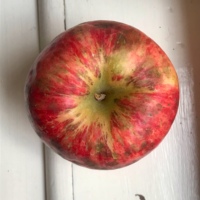
The crisp smell of apples was a top note in Wright’s own description of the smell of Taliesin. Credit: Steve Sikora
Middle notes appear just as the top note fades. These odors comprise the heart of the bouquet. They often temper the pungent impression of base notes that follow. Heart notes are mellow and rounded. Wright fails to mention the smell of his natural building materials in Sniff Taliesin, but that palette comprises the heart of the Taliesin fragrance. Middle note smells include masonry, wood, plaster, and concrete.
Bass notes appear as the middle notes begin to dissipate. The bass and middle notes linger the longest. They ally to comprise the overall theme of the fragrance. Bass notes are musky and animalistic. In this case, Wright’s acrid “fumes of burning oak” as well as the smells of human habitation are bass notes of Sniff Taliesin. The incense of wood smoke and humanity compounded by the lingering aroma of natural building materials in my opinion is what Eau de Wright house smells like. Spend some dedicated time in one of his homes and I think you will agree.
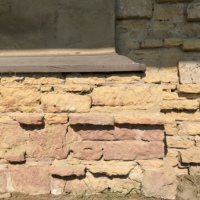
Plaster, wood and local stone contribute to the olfactory experience of Taliesin. Credit: Steve Sikora

Above all, burning oak is the smell most redolent of Taliesin. Credit: Steve Sikora
READ THE REST OF THE SERIES
Part 1: The Open Plan Kitchen
Part 2: Influencing Vernacular Architecture
Part 3: The Inner City Usonian
Part 4: A Bridge Too Far
Part 5: The Best of Clients
Part 6: Little Triggers
Part 7: Step Right Up
Part 8: A Rug Plan
Part 9: Hucksters, Charlatans, and Petty Criminals
Part 10: Lo on the Horizon
Part 11: Origins of Wright’s Cherokee Red
Part 12: One Thousand Words
Part 13: The Plow that Broke the Plains
Part 14: Separated at Birth
Part 15: Trading Drama for Poetry
Part 16: A Red By Any Other Name
Part 17: Roll Down to Levittown
Part 18: Cherokee Red The Rejoinder
Part 19: Nothing Lasts Forever
Part 20: The Struggle
Part 21: Giving What They Had to Give
Part 22: Calling the Kettle Back—Chapter 1: The Kettle
Part 22: Calling the Kettle Back—Chapter 2: The Crane
Part 22: Calling the Kettle Back—Chapter 3: Plagued By Fireplaces
Part 22: Calling the Kettle Back—Chapter 4: A Heritage of Cooking Fires
Part 22: Calling the Kettle Back—Chapter 5: Benefits of the Fireplace
Part 22: Calling the Kettle Back—Chapter 6: Transcendental Flame
Part 22: Calling the Kettle Back—Chapter 7: Repatriation


